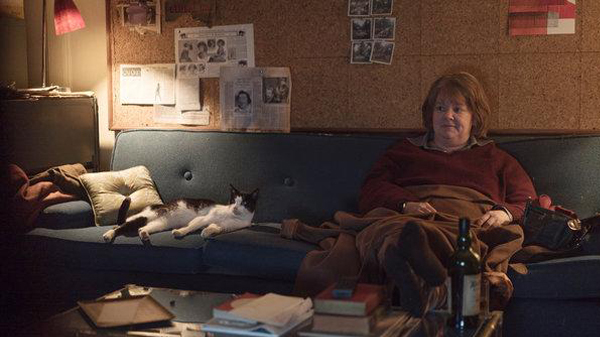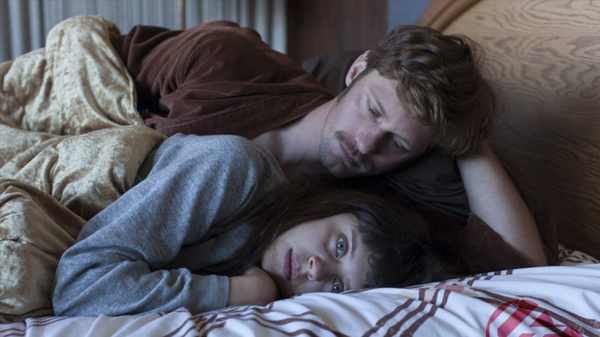READ ME is a platform for female-led writing on film hosted by Girls on Tops. Louisa Maycock (@louisamaycock) is Commissioning Editor and Ella Kemp (@efekemp) is Contributing Editor.
Craving love and creating art, Minnie Getz and Lee Israel lead the two films of compassionate filmmaker Marielle Heller. Yasmin Omar celebrates the unicity of these women.
Fifteen-year-old Minnie Getz (Bel Powley) struts through a sunshine-soaked park by herself in the establishing shot of The Diary of a Teenage Girl. In Can You Ever Forgive Me?, the opening image sees the fading biographer Lee Israel (a dowdy Melissa McCarthy), also framed alone, swilling a whisky soda. From the outset of her films, director Marielle Heller foregrounds the isolation of her protagonists, estranged from the American cities they call home. For Minnie, it is her sexual voraciousness – culminating in an affair with her mother’s boyfriend Monroe – that has precipitated her status as a pariah. Handing out $5 blowjobs and labelled a slut by her classmates, she is policed for her carnal appetites. Even her lover denigrates her lust, asking her “What are you? Some kind of nympho?”. The belittling ‘what’, rather than ‘who’, suggests the sexually adventurous are somehow subhuman.
While Minnie yearns for human connection, Lee actively spurns it, keeping others at arm’s length with her misanthropic demeanour. Her dialogue groans with insults – she barks “fuck off”, “jackass” and “rude little ape” in the first 20 minutes alone – and discourages conversation when drinking at Julius’ bar (a stomping ground of social interaction) by wearing headphones to discourage anyone from approaching her. Minnie defines her solitude as a character defect, mournfully asking, “What’s the point of living if nobody loves you? Nobody sees you? Nobody touches you?”, whereas Lee is resigned to her separation from the outside world. “I like my alone time”, she tells bookshop owner Anna – while they’re on a date.
They may feel differently about their solitude, but the ways Minnie and Lee handle it are remarkably alike: they incorporate amorous memories from the past into the present, as a means of guarding against their ostracism. In Diary, Minnie captures a moment of post-coital satisfaction after she loses her virginity by taking a Polaroid picture, thereby creating a physical token of her current happiness. She later draws herself from that same photograph, marking her second attempt to return to that fleeting bliss. Similarly, after she shares her first kiss with Monroe, Minnie wistfully grazes her fingertips over her mouth in the bathtub, mentally substituting them for his lips.
As Lee swats dead flies off her pillowcase in Can You, the romantic ballad ‘I Thought of You Last Night’ plays, whose incantatory lyric “I’ll wait for you and wait for you/And long to hold you tight” leads Lee to reminisce about the love she had for her ex-girlfriend Elaine. It’s revealing that the two times Lee calls Elaine are when she’s alone in her (double) bed, more aware than ever of the literal and figurative emptiness her partner has left behind.
Minnie and Lee both have cats – a stereotypical mainstay of the lonely woman – who act as stand-ins for human affection (particularly Lee’s feline Jersey, who was a gift from Elaine). Tellingly, Minnie’s cat Domino is the first living being we see her engage with in the film: prior to professing her adoration of him, she directs her confessions to an insentient tape recorder. Domino is her confidant, privy to her sexual dalliances before her best friend Kimmie.
To Lee, her cat is “the only true soul who loved me ever” – and it is only when Jersey becomes ill that she is driven to committing fraud so she is able to pay for medicine. The biographer’s relationship with her pet is maternal (a far cry from the expletives she usually spews at people) highlighted when McCarthy enthusiastically bellows “Mama’s home!” as soon as she sets foot in the door. When Jersey is killed at the hands of her partner in crime Jack Hock, Lee cradles the feline’s corpse while Richard E Grant blurs into soft focus in the background, indicating how her two-sided human connection fades into insignificance compared with her one-sided animal one. Jack’s betrayal encourages her to call into question their entire relationship: the actress bristles as she delivers her grieving character’s line “We’re not friends, I don’t think we ever were”.
When even the allure of plunging into a rose-tinted past fails to appeal, Minnie constructs a utopian fantasy realm, beautifully communicated through Powley’s performance of wide-eyed wonder. The instant she is aroused in a record store, cartoon penises explode from boys’ crotches with an onomatopoeic “Boing!”. A swarm of whistling, illustrated butterflies flutter around her head as she chats with her schoolgirl crush. Before embarking on her affair, she wills a flirtatious Monroe into reality through the power of her imagination. Minnie sketches his likeness in a line drawing, then strokes his face until the penciled outline turns into into a live-action Alexander Skarsgard nervously complimenting her breasts, surrounded by childish symbols of love (animated birds, flowers, hearts) as the score swells with a magical flourish of windchimes.
Much like the way Lee simulates companionship by incessantly quoting the movie Little Foxes in her empty flat, Minnie literally conjures someone to talk to out of thin air. Having begun an epistolary correspondence with the graphic artist Aline Kominsky, Minnie pictures her as a russet-haired cartoon walking down the streets of San Francisco with her. “I have no friends. I don’t want to go to school ever again,” she tells Aline. “Nobody loves me. Maybe I should kill myself?” Minnie is so lacking in empathetic people to confide in (her friend Kimmie judges her, her sister Greta slut-shames her) that she resorts to communicating with a dreamt-up ally. Throughout Diary, Minnie finds safety within the established confines of her imagination.
Minnie’s heart-on-sleeve candour in her relationships opposes Lee’s barrier-building avoidance. The teenager bundles up her self-worth in how her lovers perceive her. “I want a body pressed up next to me so that I know I’m really here,” she admits as she glides her hands across her naked figure, supplying the touch that she desperately craves. Her mother, in keeping with the 1970s’ attitude of sexual liberation, endorses this behaviour, advising her tomboy-presenting daughter wear makeup and skirts, and criticising Minnie for not, to her knowledge, pursuing male attention. “I wonder what’s wrong with you?”, she says. “I thought you’d be more into boys”.
When Monroe dumps Minnie, she seeks solace in the arms of her classmate Ricky, who subsequently rejects her for being “so passionate”. To come to terms with the awkwardness of this encounter, Minnie again enters the controlled parameters of fantasy, for the first time becoming an animated outsize version of herself who tosses Ricky aside, before thudding back into her unappealing live-action reality. Can You reveals that Lee caused the demise of her relationship with Elaine by obstinately eschewing closeness. “There was always a wall between us”, Elaine explains when they meet in Central Park upon Lee’s request after Jersey’s death. “You did everything you could to keep your distance.” The same goes for new attachments. After Lee’s unlikely date with Anna, the static camera shows her – dressed in a signature ratty jumper and boxy corduroys – backing away from the other woman’s touch and, by proxy, intimacy itself. Neither Minnie nor Lee’s tactics succeed in diminishing their loneliness.
As Heller told IndieWire, ”One connection between Minnie and Lee is that... [they] use their art to struggle through pain. It’s something I relate to and every other artist and writer can relate to.” In Diary, Minnie aspires to be a cartoonist and is often seen copying images lifted from photographs. She complains to Aline about her difficulty summoning the motivation to draw every day, to which the artist responds, “Alienation is good for your art.” This rings true for Minnie: it is only when Monroe cuts ties that she seriously pursues originality in her creations – sketching herself drowning in the throes of heartbreak, and selling her portraits and zines on a local pier.
Commensurate with Minnie’s early, replication-based art, Lee imitates the styles of fellow writers in her literary forgeries. Ironically, she traffics in communication with her inauthentic letters and has a knack for portraying human emotion – so much so that Noël Coward's 2007 biography contained two of her counterfeit missives. What spurs Minnie to throw herself into drawing is the failure of her relationship with Monroe; yet Lee pledges to fully commit to writing when she is sentenced for her crimes. She admits that cowardice dissuaded her from composing self-reflective stories, but she eventually asserts herself as she taps away at her autobiography on a brand new computer in the film’s dénouement. Through the voices of celebrated writers, Lee finds her own. At the end of both films, Minnie and Lee stop copying and scribe their own personal narratives.
Minnie finally learns to extricate her sense of value from the value men have apportioned her, which allows her to form meaningful human connections. Cartwheeling and frolicking across a beach with Greta (with whom she previously had an acrimonious relationship), she loses herself in a freewheeling display of youthful abandon. “So maybe nobody loves me,” says Minnie. “Maybe nobody will ever love me. Maybe it’s not about being loved by someone else”. Her closing statements are still hesitant, but compared to the barrage of rhetorical questions that initially characterised her speech, they are positively adamant. Whereas Minnie tended to lunge for affection from the wrong sources, Lee originally found refuge in solitude, locking out her tormentors in the protective sanctuary of her Upper West Side apartment. Her efforts to allay her standoffishness result in new bond, peeling away her nostalgia for relationships past and ensuring she finally looks forward. Both these women create richer lives and better art by prioritising self-validation over self-preservation.
Yasmin Omar (@yasmin_omar6) is a digital entertainment writer at Harper's Bazaar. She loves coming-of-age movies, the French New Wave and wearing lilac pleather boots to junkets.



